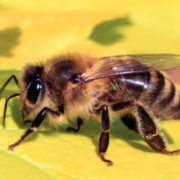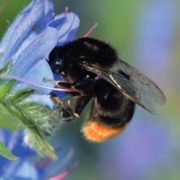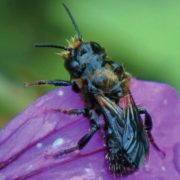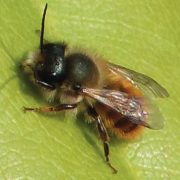Thank you for taking part in our Bees and Seeds project. We are very grateful for your help and assistance – so are the bees! Your work will help us understand and save bees both now and in the future.
What can we do to help?
Campaign for bee protection – inform your local neighbourhood, your school, your place of work or your family of the difficulties bees face.
Cultivate more flowers – plant bee-friendly plants in your own garden.
Count the bees – can you identify and monitor the bees in your own garden?
Feed the Bees!
Campaign: plant Nigella seeds, or love-in-a-mist, in your own garden and encourage the bees to visit your home (the outside of it, at least). Nigella is a beautiful flowering annual plant that is very attractive to bees.
Cultivate: if we all plant Nigella seeds, we can provide a new food supply for our bees throughout the country!
Count: after you have planted and grown your Nigella seeds, we’d love it if you could spend just an hour, each week, counting the bees that visit those lovely bright coloured flowers- and then tell us what you found by clicking the button below. Scroll down for a reminder on the type of bees!
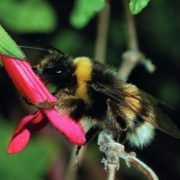 Name: Banded White-tailed Bumblebee, Bombus Terrestris, or Bombus Lucorum
Name: Banded White-tailed Bumblebee, Bombus Terrestris, or Bombus Lucorum
When to see: March to November
Description: The banded white-tailed bumblebees are a group of bees that are exceedingly difficult to tell apart to the casual observer. The workers of the different species are almost identical! They are the classic bumblebee, with a yellow band on the head and the front of the abdomen, and a white tip to the tail. Common and easily identified. They are often kept in commercial glasshouses to fertilise the plants and encourage a good crop of tasty fruit.
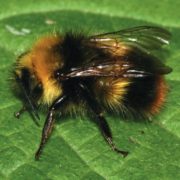 Name: Early Bumblebee, Bombus Pratorum
Name: Early Bumblebee, Bombus Pratorum
When to see: March to June
Description: t’s unlikely that you will see the early bumblebee, since it may have finished nesting by the time the Nigella seed flowers. This bee looks very similar to the white-tailed bumblebee, but it has darker orange tip to its tail instead of the white tip. It is smaller than other species.
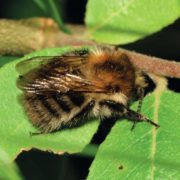 Name: Brown Banded Carder Bee, Bombus Humilis
Name: Brown Banded Carder Bee, Bombus Humilis
When to see: March to November
Description: This bee looks more like a honey bee than the other bumblebees, but is larger and covered with fur. It is mostly brown in colour and one of the less common bumblebees. It has an unusually long tongue and thus tends to favour long, tube-shaped flowers. It is particularly fond of bean or pea flowers.
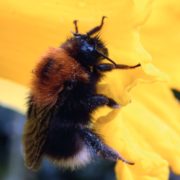 Name: Tree Bumblebee, Bombus Hypnorum
Name: Tree Bumblebee, Bombus Hypnorum
When to see: March to July
Description: A newcomer to the UK, this bee was first seen here in 2001. It will be very interesting to see how it has spread. It looks similar to the white-tailed bees, but the tree bumblebee has one band of orange on the thorax, instead of two bands of yellow like the white-tailed bees. It may have finished nesting for the year by the time the Nigella seeds have flowered, but if you have seen it in your garden, we would love to hear from you!
Solitary Bees
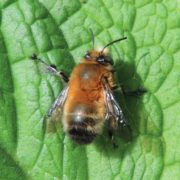 Name: Hairy Footed Flower Bee, Anthophora Plumipes
Name: Hairy Footed Flower Bee, Anthophora Plumipes
When to see: March to June
Description: These bees look very similar to bumblebees, but are darker in colour. They move quickly and can be hard to catch sitting still to identify. They favour a range of wildflowers, in particular dead nettles.
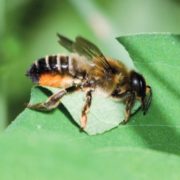 Name: Leafcutter Bee, Megachile Species
Name: Leafcutter Bee, Megachile Species
When to see: May to August
Description: This bee is not liked by gardeners, because it chops holes out of the edge of the leaves of their plants! If you find half-circles cut out of leaves in or near your garden, there must be leafcutter bees around. There is a huge number of different species, but they are not distinguishable to the casual observer.
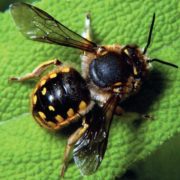 Name: Wool Carder Bee, Anthidium Manicatum
Name: Wool Carder Bee, Anthidium Manicatum
When to see: May to July
Description: This solitary bee looks like a wasp, but it is really a bee. It is slightly bigger and less slender than a wasp. This bee makes its nest from balls of plant material, and likes to collect parts from hairy plants. It can often be seen on plants with hairy leaves.


